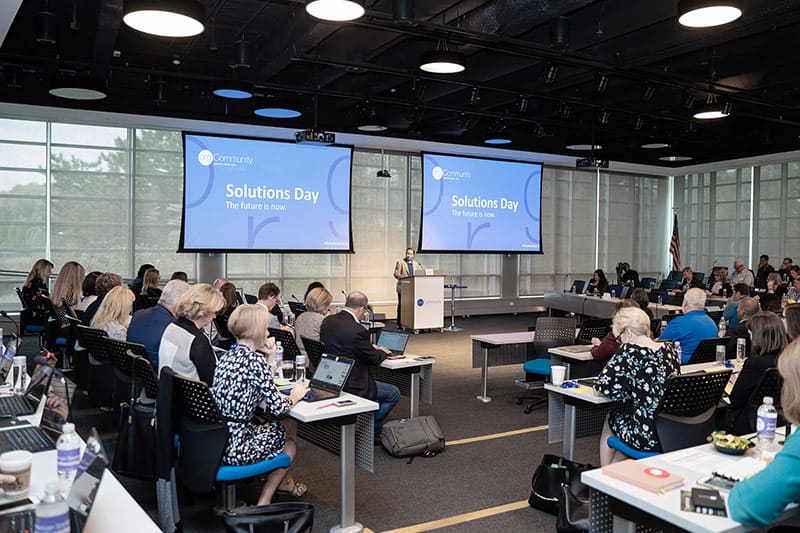
Artificial intelligence has moved into customer service departments. Whether it’s Alexa, Watson, or Hal, you can’t visit a website without a super-friendly little bot popping up on the right side of your screen. We are accustomed to the convenience of getting questions answered immediately.
Associations haven’t been so quick to jump on the AI bandwagon. I just visited six prominent sites and was only greeted by one bot. But new features that make planning and conducting virtual and in-person meetings of all sizes more productive may change that.
The rise of AI is sometimes cast in the unsettling context of evil bots taking over jobs that should rightfully belong to humans. The new applications for meetings are AI at its finest, eliminating tedious work and freeing us to exercise our creative potential.
In case you aren’t familiar with the landscape, these are some of the technologies that are included under the AI umbrella:
- Robotics
- Speech to text, and text to speech
- Machine learning
- Natural language processing
- Bots and apps
With the rise of online meetings, innovators and entrepreneurs are working overtime to develop new platforms that promise to make our business lives easier. Current features are rapidly growing more robust and increasingly innovative applications are coming through the pipeline.
Create a Professional Environment
It’s amazing how rapidly Zoom evolved. Early forays into virtual space were often accompanied by people and sounds that had no business being there.

Today, even if the dog is howling and you can’t keep your young gamers out of the home office, you can still look like a competent professional or take up temporary residence in a host of other more soothing environments. From majestic landscapes to sleek office space, Canva and other platforms offer hundreds of virtual backdrops so that your personal space remains just that—personal.
Noise cancellation software like Krisp, and other digital acoustic fencing platforms, eliminate the need to remind participants about the mute button. Echoes and distracting sounds are filtered out so that speakers’ voices remain crystal clear.
Read the Room
In the near future, facial recognition might help your virtual meeting attendees get to know each other or speed members through a registration line. Biometric technology matches facial characteristics to other identifying documents for a quick readout.
This software can create name labels to identify speakers and participants and provide information about them during the event.
Facial recognition is rapidly becoming more sophisticated. Japan Airlines and Accenture are already using AI features at several of their international check-in counters.
As early as 2017, facial recognition software was available to support conference registrations. Biometrics help to speed the process, ensure security, and eliminate badge sharing. This convenience is likely to soon be more widespread in the association world.
Although facial recognition comes with privacy concerns, just as people have embraced online payments, they will probably quickly become accustomed to the greater convenience and safety offered by biometrics.
When you can’t see someone’s face, sentiment analysis adds a new tool to deliver customer satisfaction. Powered by natural language processing, sentiment analysis takes digital speech to a new level and interprets emotions based on the words that a person uses. For example, IBM’s Watson Tone Analyzer enables chatbots to adjust their dialogue to a customer’s level of satisfaction. Supervisors can also assess whether customer service agents are responding appropriately to the situation.
In the future, this software could help identify meeting attendees who are uncomfortable with a decision or an idea, and allow a facilitator to contact them or provide them with additional information.
Let Creativity Flow

The last time you asked for a volunteer to take notes, was there a competition to sign up? Most people don’t enjoy the administrative tasks that accompany a board or committee meeting. Organizing the event and following up afterward often require more time than the meeting itself.
AI makes light of many of these tedious functions freeing staff and volunteers for more creative work. Scheduling, recording, and transcription are a few of the activities that digital assistants like Aria and Alexa can tackle. A bot can:
- Check participants’ calendars to identify their availability
- Distribute the meeting invitation
- Alert you to people who should participate that you may have overlooked
- Access relevant documents both before and during the meeting
- Take notes
- Distribute the minutes
Beyond simply providing a transcript, AI can be programmed to recognize keywords. It’s possible to flag, search, and select for action items or other significant meeting outcomes such as deadlines, goals, and objectives.
While AI manages the mundane tasks that it does best, your human staff can focus on enhancing member satisfaction and strengthening those priority relationships.
Get Feedback
The absence of body language and subtle visual cues is one of the most challenging aspects of virtual meetings. When the event is crowded, those tiny squares make it difficult to tell whether participants are attentive and enjoying your presentation or finding you snooze-worthy. An application called Headroom recognizes positive gestures such as smiles and nods and translates them into emojis. Speakers can gauge the audience’s reaction to their presentation in real-time. This is either scary or enlightening depending on your tolerance for constructive criticism.
The emerging field of emotion recognition uses the same sort of technology to assess how the ambiance is changing throughout an event. Expressions like frowns, surprise, smiles, and raised eyebrows are converted to metrics that can be displayed on the computer screen or analyzed afterward.
Shrink the World
Expand your reach by making participation easy for people across the globe. The need to hire translators at international meetings may soon be a thing of the past. From Hindi to Chinese, an application called Wordly provides instantaneous translation in 15 languages. Attendees can use their mobile devices to see the translated text on the screen or hear it using their headsets. Wordly’s producers say they can support an audience of 1,000 people and 15 parallel sessions simultaneously.
Take the Lead
Some of these meeting-friendly technologies may already be in your tool kit. Others are still too young to be practical for most associations. I urge CEOs and planners to stay abreast of what is innovative and exciting in the AI space. The digital marketplace is moving fast. Alexa may not live at your house yet. But she, or someone like her, should be on the agenda to take your organization’s meetings to a new level of productivity.


